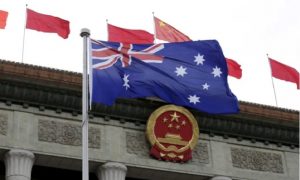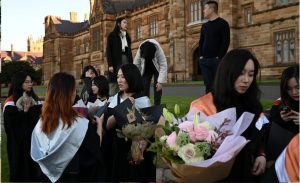11-11-2021
MELBOURNE/ SYDNEY/ BEIJING: Before the COVID-19 pandemic hit, Raj Kiran Grewal, who lives in Mohali in India’s Punjab state, saw Australia as the ideal place to do her MBA but after spending 20 months trying to get around the country’s ultra-strict border controls, Grewal is so sick of “false hopes” that she is considering studying in the United States or Canada instead.
 “Australia is definitely not the right option as they just want the money from international students and they do not care about the rest,” Grewal said.
“Australia is definitely not the right option as they just want the money from international students and they do not care about the rest,” Grewal said.
“I am really frustrated with the way the college and immigration treated the stranded overseas people including international students, and family members of the people living in Australia as well,” she added, explaining how she deferred her course when Australia shut its borders in early 2020 only for her university to cancel her enrollment after she declined to accept the option of studying online.
Grewal is one of many international students who have looked elsewhere during Australia’s self-imposed isolation, raising fears of long-lasting damage to one of the country’s most lucrative industries.
Students from China, India and other Asian countries have long been drawn to Australia to study due to its high-ranking universities, English-speaking environment and comfortable lifestyle. Before the pandemic, international education contributed 40 billion Australian dollars ($29.5bn) to the economy, making the sector the fourth-largest export after iron ore, coal and gas.
 International students made up 21 percent of all university enrollments in 2019, compared with an average 6 percent among developed countries, according to Organization for Economic Co-operation and Development (OECD) figures.
International students made up 21 percent of all university enrollments in 2019, compared with an average 6 percent among developed countries, according to Organization for Economic Co-operation and Development (OECD) figures.
As Australia’s decision to shut its borders in March 2020 pushed people to look elsewhere, international enrollments plummeted by more than 200,000 in the 20-month period up to August of this year, according to Department of Education, Skills and Employment data.
In August, the number of students from overseas sank to its lowest number since 2015, at just over 550,000. Chinese nationals made up the biggest proportion of foreign students, followed by those from India, Nepal, Vietnam and Malaysia.
Earlier this month, recruitment platform Adventus reported that applications by international students had declined by 51 percent since March, whereas applications to Canada, the UK and the United States had soared by 148-422 percent.
 Although Australia reopened its borders to citizens and permanent residents on November 1, the government has not provided any timetable for when international students will be able to return to the country en masse.
Although Australia reopened its borders to citizens and permanent residents on November 1, the government has not provided any timetable for when international students will be able to return to the country en masse.
States and territories including Victoria and New South Wales have announced pilot schemes to welcome international students in extremely limited numbers from next month. Federal Education Minister Alan Tudge said in October he hoped tens of thousands of students would be able to return sometime next year.
About 145,000 student visa holders currently exist in limbo overseas after deferring their studies or opting to do their coursework online.
Financial fallout
Sovia Gill, an international student who has been studying online from her hometown of Kapurthala, in India’s Punjab state, since early 2020, said a number of her friends had switched to universities in Canada due to Australia’s lack of clarity on reopening.
 “They are already settled in,” Gill, who is studying for a masters in engineering at the University of Southern Queensland, said.
“They are already settled in,” Gill, who is studying for a masters in engineering at the University of Southern Queensland, said.
“Because I am already halfway through my program, I have spent thousands of dollars already. I can’t drop it and waste all that money.”
Some analysts have warned of year-long financial fallout for the sector. In August, the Melbourne-based Mitchell Institute predicted the industry had yet to see the worst of its losses after university profits plunged $1.6bn in 2020.
In a report the same month, Ernst & Young suggested demand for higher education might never recover to pre-pandemic levels, with university revenues potentially declining by $5-6bn by 2030.
“I think universities are nervous,” Peter Hurley, an education policy fellow at the Mitchell Institute, said.
“I think, though, that even an intake that is much lower than pre-pandemic days would be a relief!”
 Hurley said that lasting damage was a concern, but he was optimistic about the medium to long-term outlook given the sector’s “enormous resilience in the face of the pandemic.”
Hurley said that lasting damage was a concern, but he was optimistic about the medium to long-term outlook given the sector’s “enormous resilience in the face of the pandemic.”
Andrew Norton, an expert in higher education policy at Australian National University, said international enrollments would not return to 2019 levels any time soon but it was difficult to predict the longer-term trajectory.
“Australia has ongoing advantages in proximity to Asia and climate,” Norton said. “But other factors such as competitor strategies, political tensions with China, migration settings, regulatory changes around English language ability and future outlier events such as COVID could all influence the scale of the market.”
Some industry figures insist the sector’s prospects remain rosy.
Anne-Marie Lansdown, deputy chief executive of Universities Australia, which represents universities in the country, said the “fundamental attractiveness” of third-level education in Australia had not changed and students would likely return in large numbers next year.
 “Our universities remain among the best in the world, attracting scholars from more than 140 different countries prior to the pandemic,” Lansdown said, adding that 91 percent of international students surveyed in Australia in 2020 reported a positive experience in the country.
“Our universities remain among the best in the world, attracting scholars from more than 140 different countries prior to the pandemic,” Lansdown said, adding that 91 percent of international students surveyed in Australia in 2020 reported a positive experience in the country.
“Universities have worked incredibly hard to support all students who have very resiliently adapted to online learning – regardless of their geographic location.”
Even if Australia’s international education industry does eventually recover, there is no mistaking the frustration students such as Grewal feel after nearly two years in limbo.
“They should have provided more clarity about borders reopening so that students could discover something else to do in that duration,” Grewal said. “They haven’t very understood … This is the reason why statistics show a decline in the number of international students.”
 Pressmediaofindia
Pressmediaofindia




